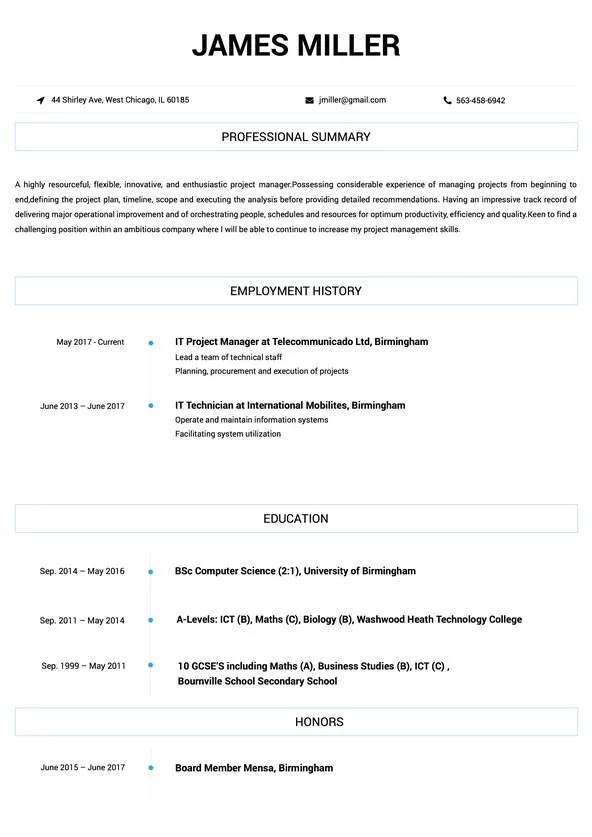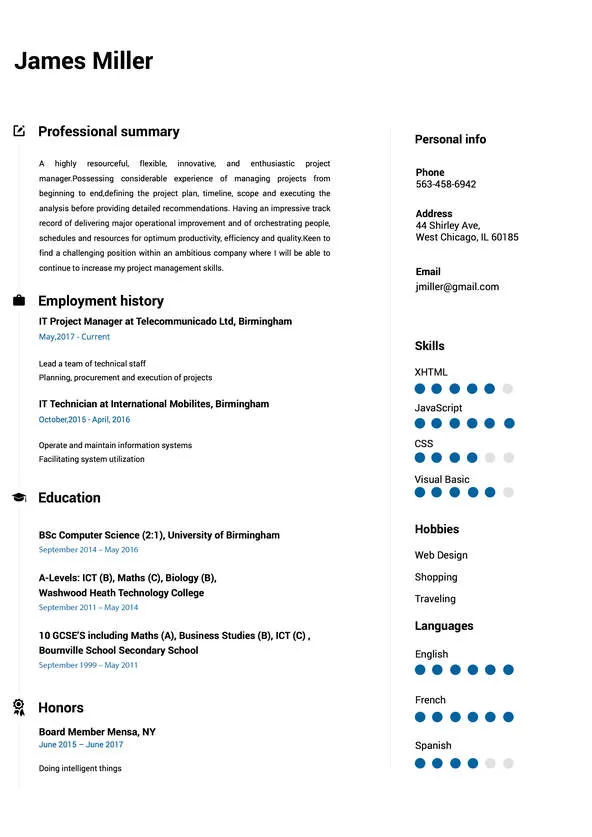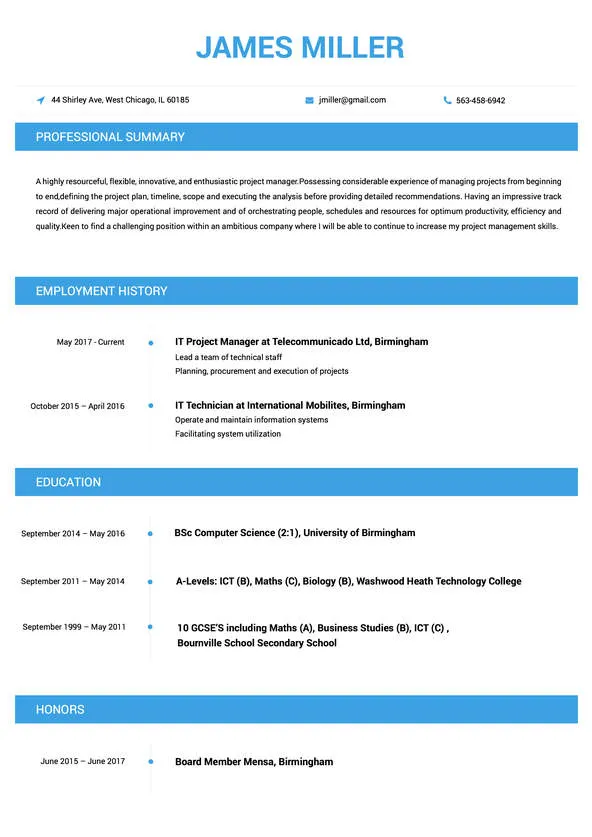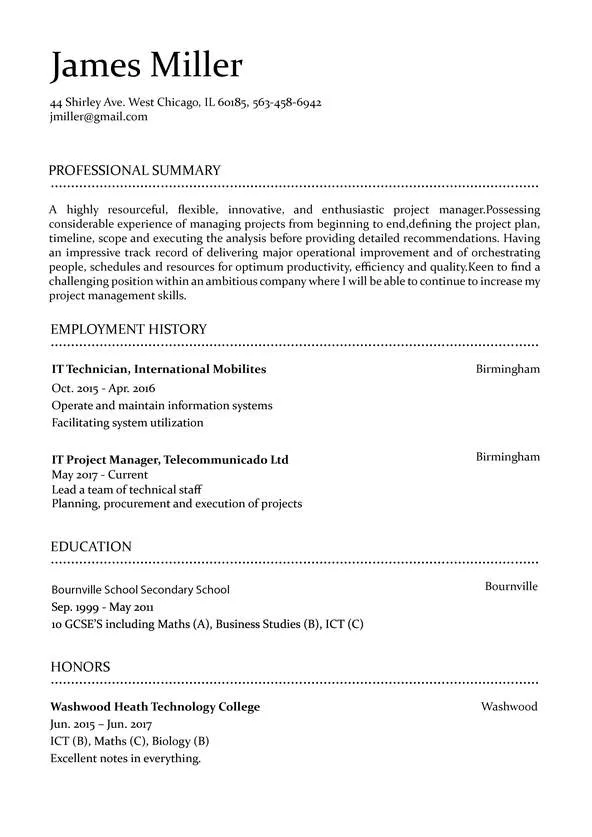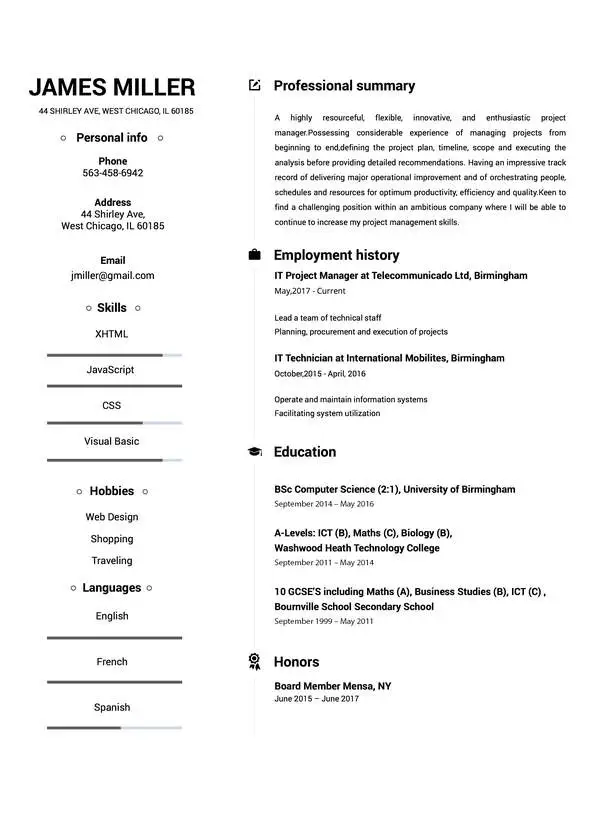 Use This Template
Use This Template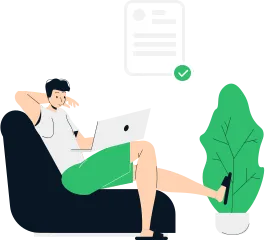
Build your resume in 15 minutes
Create an awesome resume that meets the expectations of potential employers with our selection of professional, field-tested resume templates.
teacher: Resume Samples & Writing Guide
Employment history
- Prepare lesson materials
- Manage student behavior in the classroom
- Develop and implement engaging lesson plans
- Prepare lesson materials
- Participate in professional development activities
- Provide individualized instruction
- Manage student behavior in the classroom
- Incorporate technology into the classroom
- Assign and grade homework and exams
Education
Skills
Do you already have a resume? Use our PDF converter and edit your resume.
Professional Summary
Employment history
- Participate in professional development activities
- Utilize a variety of teaching strategies
- Assign and grade homework and exams
- Manage student behavior in the classroom
- Create and maintain records of student progress
- Maintain up-to-date knowledge of curriculum standards
- Incorporate technology into the classroom
- Establish and maintain positive relationships with students
- Promote a positive learning environment
Education
Skills
Professional Summary
Employment history
- Assign and grade homework and exams
- Communicate with parents and guardians
- Manage student behavior in the classroom
- Communicate with parents and guardians
- Develop and implement engaging lesson plans
- Establish and maintain positive relationships with students
- Monitor and assess student performance
- Establish and maintain positive relationships with students
- Incorporate technology into the classroom
Education
Skills
Professional Summary
Employment history
- Communicate with parents and guardians
- Provide individualized instruction
- Assign and grade homework and exams
- Provide individualized instruction
- Create and maintain records of student progress
- Communicate with parents and guardians
- Monitor and assess student performance
- Assign and grade homework and exams
- Manage student behavior in the classroom
Education
Skills
Employment history
- Prepare lesson materials
- Assign and grade homework and exams
- Monitor and assess student performance
- Participate in professional development activities
- Communicate with parents and guardians
- Collaborate with other teachers and administrators
- Provide individualized instruction
- Participate in professional development activities
- Collaborate with other teachers and administrators
Education
Skills
Not in love with this template? Browse our full library of resume templates
Job searching can be daunting—or even downright difficult at times. And education can be an especially competitive field. Teachers today are an incredibly important part of our society. They help set up children to be successful citizens of the world afterall.
All that’s to say, school boards and administrators take hiring new teachers seriously. In order to even land an interview, you need a top-notch teacher resume.
In this writing guide, we’ll cover what it takes to create a resume that’s guaranteed to stand out. We’ll include template examples and go into great detail about how to write the perfect teacher resume. Throughout this guide, you’ll learn:
- How to properly format your resume
- What recruiters, school boards, and principals look for in a teacher’s resume
- What skills you should mention (and how to demonstrate them correctly)
- What achievements you should include on your resume
- Things you should avoid mentioning and other common resume mistakes
- How to write a great resume objective or summary section
- How to list teaching association memberships
- How to list certifications, licenses, volunteer experience, and other interests
- How to write a teacher resume if you have little to no experience
We’ll also give you top tips and tricks for ways to tweak your resume for each school and position you apply to. You’ll be equipped with all the knowledge to write a resume that is sure to stand out and land you an interview.
Let’s start with some teacher resume template examples.
Multiple template examples
How to write a perfect teacher resume?
There are many things that go into writing the perfect resume. Unfortunately, it isn’t as easy as just word-dumping onto a piece of paper. It takes time and thoughtful effort to write something that will catch a recruiter’s eye.
To do so, you need to show why you’re a competitive candidate with concrete, creatively crafted words. Typically, teachers should plan to highlight their relevant teaching experience, education, credentials, certificates, and position-specific skills.
Though it might be tempting to send the same resume out to each position you apply to, you should think twice about doing this. Every position is as unique as the school and district it’s at. Tailoring your resume for each job application will make you a much more competitive candidate.
Writing a perfect resume also means writing about your accomplishments, not just your job responsibilities. It’s certainly important the hiring managers get a sense of what you do—and what you were responsible for—but that’s not enough.
Recruiters don’t just want to know what you do. (They know what teachers do. Who doesn’t?) They want to know how well you can do it. A teacher who does the bare minimum won’t bring nearly as much value as a teacher with a long list of classroom accomplishments.
Don’t sell yourself short. Focus on what types of change you brought at your previous places of employment and include them on your resume. What you write can make or break your candidacy.
Once you’re happy with the content of your resume, start thinking about formatting.
How to format it
A resume that isn’t formatted properly is a resume that will get tossed in the trash. Though it used to be common practice to create a resume in Microsoft Word, that’s now an outdated way to format your resume.
And it’ll stand no chance against resumes that were professionally-designed with formatting in mind.
A properly formatted resume should include the following sections:
- A header section that includes your name, phone number, and email address
- An objective or summary section demonstrating why you’re the right person for the job
- An experience section that highlights your previous teaching positions and accomplishments
- An education section that includes your college or university as well as your degree
- A skills section that shows you have the tools needed to succeed
As a general rule of thumb, your resume should never be more than a page in length. If you’re struggling to condense your content, try using a resume template. They’re designed to maximize space so you can make the most of every word.
And speaking of words, your text should always be easy-to-read at a 100% zoom level. Meaning, a recruiter or principle shouldn’t have to zoom in on your resume in order to be able to read it.
And lastly, remember that your resume should always be sent in PDF format. Otherwise, the formatting can get messed up when it’s opened on a new device.
Those are the basic rules of resume formatting. Next, we’ll review exactly what recruiters look for in a teacher’s resume.
What recruiters will look for
Recruiters want to hire someone they know will succeed. That being said, there are certain things they’ll look for in a teacher’s resume.
They want to see what you can accomplish. Here are some accomplishment examples teachers can add to their resume:
- Improved student tests scores by 8% from the previous year
- Developed a new science curriculum that resulted in a 13% improvement in state testing scores
- Improved overall pass rates from 78% to 85%
- Teaching awards
- New programs and the results of those programs
It’s best to demonstrate your achievements numerically whenever possible. Doing so adds to your credibility tremendously.
Recruiters also want to see that you’ve tailored your resume to the job. And trust us when we say, it’s clear if you don’t. Your resume should demonstrate why you’re the right teacher for the position, not just that you’re a great teacher in general. There are lots of great teachers. That doesn’t always mean they’ll be a good fit culturally. Or that they have the necessary skills to succeed in this specific position.
Read the job description carefully and tailor your resume based on the required skills and responsibilities. But don’t make the mistake of adding the obvious. For example, you don’t need to say that you did lesson planning. Every teacher does lesson planning. All that says is that you do your job. And that is already a given (or at least it should be).
We’ll go into more detail below about the best ways to target your resume for each application. But first, let’s talk more about which skills recruiters will look for.
What skill to mention and how to do it correctly
Your teacher resume should feature a skills section. In it, you can include both soft skills and technical skills that teachers frequently use. Typically, soft skills are a focal point, but sometimes schools use specific technology in their classrooms. If that’s the case, it’s best to add them to your resume.
Here is a list of common teacher skills to add to your resume:
- Classroom management
- Student advocacy
- Conflict resolution
- Patience
- Teambuilding
- Leadership
- Organization
- Adaptability
- Creativity
- Behavior Management
- Blackboard
- Powerpoint
- Microsoft Office
Soft skills are best demonstrated through real-world examples. Explain in 2-3 sentences how you used these skills in a classroom setting. It’s much more impactful than just adding them to a list.
What achievements to mention and how to do it correctly
Including achievements on your resume is another great way to make you a more competitive candidate. Include certifications you’ve earned as well as any teaching awards you’ve won.
This can be a standalone section on your resume or it could be included elsewhere.
What to avoid mentioning
Avoid mentioning anything that’s irrelevant or obvious on your resume. Whether it’s previous jobs or interests that are unrelated to teaching, if they don’t add value to your resume they aren’t worth including.
Every word on your resume should add value. If it’s there just to fill space, it doesn’t belong. Find something else to add or use the extra white space to your advantage.
How to write a resume objective and examples of this
A great resume objective shows your personality, passion, and career-related goals. It should be short and sweet—just two to three sentences. And it should make a recruiter want to keep reading the rest of your resume.
All that’s to say, there’s definitely a right and wrong way to write a resume objective. Here are examples of both:
Elementary school science teacher, graduate of the University of Iowa, with 2 years of teaching experience seeking a new teaching position.
This summary gives only very basic information. And a recruiter can gather all of this from other sections of a resume in about 5 seconds. It doesn’t make you want to read more. And it certainly doesn’t add any value.
This summary section, on the other hand, is much more engaging and makes a recruiter think, “Wow, we have to hire this person.”
Elementary school science teacher with 2 years of teaching experience. I’m passionate about cultivating STEM knowledge in students and encouraging girls to explore careers in science. I’m seeking a new position where I can improve test scores and launch a GirlsWhoCode club.
This resume objective is much more engaging. You get a much better sense of the person and their goals. It incorporates specific details about the candidate and shows administrators exactly how their school will benefit if they hire this person.
This is a resume objective that is much more impactful.
How to write a resume summary and examples of this
If you don’t want to write a resume objective, you can opt for a resume summary instead. It really depends on personal preference and whichever option you think can better communicate why you’re the right person for the job.
An objective is more focused on your goals while a summary tends to focus more on your experience and accomplishments. Just like a resume objective, your resume summary should focus on the specific details that set you apart from other candidates.
Writing a vague summary adds little, if no, value to your resume. Here are two examples of resume summaries (both bad and good):
Math teacher with 4 years of experience teaching algebra.
This summary could apply to hundreds, if not thousands, of math teachers. Meaning, it won’t help you stand out. It could even be the decision factor in whether or not the recruiter decides to keep reading.
Compare that summary with this summary, which is much more specific.
High school algebra teacher with 4 years of experience. My students average in the 80th percentile for state-wide tests and I’ve increased school passing rates from 70% to 85%.
This summary goes into much more detail about what kind of value you can bring to a school. It gives real-world examples of accomplishments and it’s anything but vague.
This kind of summary is what’s going to catch a recruiter's eye.
How to list teaching association memberships
To list teaching association memberships on your resume, you can create a specific section called Memberships. Below it, be sure to list the organization name and your title (especially if it’s something other than a member).
And be sure to include any contributions to the membership. This could include fundraising, event planning, communications, etc.
If you’re not a current member, but still want to add it to your resume, you can list yourself as a “former member.”
How to list any additional details, like certifications, hobbies, interests, volunteer experience.
Certifications and licenses are especially important for teachers to list on their resumes. They can vary state-by-state, but many times they’re required. They should be listed in an easy-to-see spot on your resume.
Consider adding them to your resume header underneath your name as a kind of subtitle.
If you have extra space, you can also consider adding hobbies, interests, or volunteer experience. Just be sure they’re relevant to teaching or working with children. Otherwise, use that space for something else.
How to write a teacher resume when you have no experience
If you’re a recent grad who has no teaching experience, don’t worry. You can still create a compelling resume that will land you an interview.
Go into detail about your student teaching experience and show how it prepared you for the next step in your career. Include examples of successful classroom management, your ability to handle stressful situations, and how you can effectively think on your feet.
Be sure to include certifications or licenses as well as any relevant coursework you completed in college. Have you ever substituted? Be sure to add that. Did you work with kids outside of a classroom setting? Include that experience too.
How to target your resume for each application
It’s incredibly important to target your resume for each job application you submit. To most people, this sounds like a lot of work.
You put so much time and thought into writing a great first resume, the thought of doing that over and over again for each application sounds like a waste of time. But the fact of the matter is, customizing your resume is critical if you want to show you’re the right person for the job.
The good news is, targeting your resume each time doesn’t mean you need to completely reinvent the wheel. Even if you’re applying to different school districts/positions, there are a number of things you can keep the same.
For starters, you can follow the same outline and overall resume structure. No matter what, you’ll likely keep the same resume sections and some of the content within those sections. For any application, you won’t need to change which schools you’ve worked at, your titles, or your education. Other areas however will require more tailoring.
You’ll always want to update your resume objective or summary statement. This is usually your first chance to capture the attention of a hiring manager. Make sure this part of your resume always matches what they’re looking for. If the school you’re applying to focuses largely on pass/fail rates, be sure to include information surrounding that.
You’ll also want to update the bullets under your job experience. You should try to tailor them based on the needs expressed in the description of the new position you’re applying to. Think about how they measure success and demonstrate similar examples on your resume.
Another section you’ll want to update for each application is the skills section.
How to list only the relevant skills for that specific school/district and position
Updating the skills section of your resume for each school/district and position is so important. Say you’re applying for three different teaching positions with the same job title. Just because the job title is the same doesn’t mean they have the same expectations or needs when it comes to skills they’re seeking.
One of the best ways to only list relevant skills for each position is to print out a copy of the job posting and circle or highlight the qualities and strengths the recruiter is looking for in a candidate. Then, try to match these with your skills section so that you can show exactly why you’re a good fit for the role.
For example, if the position requires a teacher who has experience with Blackboard, you should intentionally include that skill on your resume.
How to make your resume stand out
As you know, education can be a competitive field. To ensure your resume gets picked from the pile, it needs to stand out. Here are some ways to do that.
Add some color.
A splash of color will stand out from stacks of black and white resumes. Adding color isn’t only pleasing to the eye, but it can also highlight different sections on your resume and make it easier to read.
Just make sure you don’t go overboard with it. Stick to neutral colors and make sure it doesn’t become overwhelming.
Use unique fonts.
Yes, Times New Roman is considered professional—and probably even the standard. But that just means you’ll blend in.
Instead, try using a font that isn’t overused. Try using Arial, Helvetica, Georgia, Garamond, or Avenir instead. They still look professional but will stand out from the rest.
Choose a professionally-designed template.
The design of your resume is the first thing employers will notice. Before they even start reading, they’ll notice what your resume looks like. Picking a professionally-designed resume is key to making a great first impression.
Use power verbs.
Begin each bullet with power verbs to emphasize your actionable accomplishments. Start sentences with words like, “increased,” “initiated,” “led,” “managed,” “developed,” and “improved”.
Using power verbs is more impactful than simply stating your duties.
Quantify your achievements.
Numbers will jump out at a recruiter. Determine what metrics your school uses to measure success (test scores, passing rates, etc.) and determine where the baseline was before you started. From there, calculate the difference you made and add it to your resume.
For teachers, it can also be helpful to incorporate numbers to show how many students you’re used to teaching at a time.
Demonstrate soft skills with real-word examples.
You can add classroom management as a skill to your resume, but what does that really mean? Without an example, it doesn’t add much value. Instead, think about a time you had to manage a tough class and how you did it.
How the Resumebuild tool could be utilized for an easy resume setup
Resume Build is an online tool that can help you create a professional, HR-approved resume in just 5 minutes or less. With more than 20 tailored-built resume templates to choose from, you can turn your resume from drab to fab in just three simple steps.
Step 1: Choose a resume template. With options for every industry, you can rest easy knowing they follow all resume guidelines and best practices.
Step 2: Show what you’re made of—and why you’re the best fit for the position. Easily upload your content right into the template. Or, if you’re struggling to find the right words, Resume Build has uploaded thousands of pre-written samples and resume examples.
Step 3: Download your resume and start sending to employers! It’s as easy as 1-2-3.
Ready to get started? Build my resume now.
teacher Job Descriptions; Explained
If you're applying for an teacher position, it's important to tailor your resume to the specific job requirements in order to differentiate yourself from other candidates. Including accurate and relevant information that directly aligns with the job description can greatly increase your chances of securing an interview with potential employers.
When crafting your resume, be sure to use action verbs and a clear, concise format to highlight your relevant skills and experience. Remember, the job description is your first opportunity to make an impression on recruiters, so pay close attention to the details and make sure you're presenting yourself in the best possible light.
teacher
- Instruct through lectures, discussions, and demonstrations in one or more subjects, such as English or social studies.
- Tutor for all the classes between ages 4 to 18 ( Class 1 to 12 )
- Trained students all the basics and conducted many interactive games.
- Guided students specially for Mathematics
teacher
- Maintain discipline in the classroom.
- Provide resources for lessons.
- Provide informative presentations to students regarding different areas of studies to ensure that all students fully comprehend all aspects of the curriculum.
- Organize group discussions.
- Mentor students with difficulties.
- Participate in ongoing staff training sessions.
teacher
- Help wash their hands before eating
- Help them get their plates for breakfast and lunch
- Pass out snacks at snack time
- During their time to play I would supervise and make sure they’re being safe and friendly and sharing
- I would color, make crafts, play board games and put puzzles together with them as well
- Vacuum
- Mop
teacher
- Adapt teaching methods and instructional materials to meet student’s varying needs, abilities, and interests.
- Observe and evaluate student’s work to determine progress and make suggestions for improvement.
- Taught Computers to middle and senior grades.
- Also served as Science Coordinator.
teacher
- Develop and implement daily and unit lesson plans for 4th grade, administer testing, track and analyze class performance.
- Conduct group and one-on-one math, reading and writing activities.
- Foster a classroom environment conducive to learning and promoting excellent student engagement.
- Serve on schoolwide Literacy committee and scheduling committee.
- Organized, codirected and presented school drama production of Aladdin Jr.
- Plan and organize grade level field trips.
- Co-teach Science and Social Studies lessons across grade level.
teacher Job Skills
For an teacher position, your job skills are a key factor in demonstrating your value to the company and showing recruiters that you're the ight fit for the role. It's important to be specific when highlighting your skills and ensure that they are directly aligned with the job requirements, as this can greatly improve your chances of being hired. By showcasing your relevant skills and experience, you can make a compelling case for why you're the best candidate for the job.
How to include technical skills in your resume:
Technical skills are a set of specialized abilities and knowledge required to perform a particular job
effectively. Some examples of technical skills are data analysis, project management, software proficiency,
and programming languages, to name a few.
Add the technical skills that will get hired in your career
field with our simple-to-use resume builder. Select your desired resume template, once you reach the skills
section of the builder, manually write in the skill or simply click on "Add more skills". This will
automatically generate the best skills for your career field, choose your skill level, and hit "Save &
Next."
- Data Analysis
- Computer Literacy
- Technical
- Project Management
- Quality Assurance
- Troubleshooting
- Database Management
- Software Development
- Programming
- Networking
- Web Development
- Systems Administration
- Cloud Computing
- Cybersecurity
- Operating Systems
- Mobile Development
- Artificial Intelligence
- Machine Learning
- Data Science
- Robotics
- Virtual Reality.
How to include soft skills in your resume:
Soft skills are non-technical skills that relate to how you work and that can be used in any job. Including
soft skills such as time management, creative thinking, teamwork, and conflict resolution demonstrate your
problem-solving abilities and show that you navigate challenges and changes in the workplace
efficiently.
Add competitive soft skills to make your resume stand-out to recruiters! Simply select
your preferred resume template in the skills section, enter the skills manually or use the "Add more skills"
option. Our resume builder will generate the most relevant soft skills for your career path. Choose your
proficiency level for each skill, and then click "Save & Next" to proceed to the next section.
- Communication
- Interpersonal
- Leadership
- Time Management
- Problem Solving
- Decision Making
- Critical Thinking
- Creativity
- Adaptability
- Teamwork
- Organization
- Planning
- Public Speaking
- Negotiation
- Conflict Resolution
- Research
- Analytical
- Attention to Detail
- Self-Motivation
- Stress Management
- Collaboration
- Coaching
- Mentoring
- Listening
- Networking
- Strategic Thinking
- Negotiation
- Emotional Intelligence
- Adaptability
- Flexibility
- Reliability
- Professionalism
- Computer Literacy
- Technical
- Data Analysis
- Project Management
- Customer Service
- Presentation
- Written Communication
- Social Media
- Troubleshooting
- Quality Assurance
- Collaboration
- Supervisory
- Risk Management
- Database Management
- Training
- Innovation
- Documentation
- Accounting
- Financial Management
- Visualization
- Reporting
- Business Acumen
- Process Improvement
- Documentation
- Relationship Management.
How to Improve Your teacher Resume
Navigating resume pitfalls can mean the difference between landing an interview or not. Missing job descriptions or unexplained work history gaps can cause recruiters to hesitate. Let's not even talk about the impact of bad grammar, and forgetting your contact info could leave your potential employer hanging. Aim to be comprehensive, concise, and accurate.
Employment history
- Prepare lesson materials
- Collaborate with other teachers and administrators
- Utilize a variety of teaching strategies
- Prepare lesson materials
- Participate in professional development activities
- Assign and grade homework and exams
- Provide individualized instruction
- Develop and implement engaging lesson plans
- Incorporate technology into the classroom
Education
Skills
Provide your Contact Information and Address Year Gaps
Always explain any gaps in your work history to your advantage.
Key Insights- Employers want to know what you've accomplished, so make sure to explain any gaps using a professional summary.
- Adding extra details and context to explain why you have a gap in your work history shows employers you are a good fit for the position.
How to Optimize Your teacher Resume
Keep an eye out for these resume traps. Neglecting to detail your job roles or explain gaps in your career can lead to unnecessary doubts. Grammar blunders can reflect negatively on you, and without contact information, how can employers reach you? Be meticulous and complete.
Professional Summary
Employment history
- Assign and grade homwork an exams
- Develp and implement engagign lesson plans
- Utilise a variety of teachin strategies
- Assign an grade homework an exams
- Manage student behavour in the classroom
- Utilise a variety of teachin strategies
- ""The dog barked loudly.
- Thhe dog barked loudly.
Education
Skills
Include Job Descriptions and Avoid Bad Grammar
Avoid sending a wrong first impression by proofreading your resume.
Key Insights- Spelling and typos are the most common mistakes recruiters see in resumes and by simply avoiding them you can move ahead on the hiring process.
- Before submitting your resume, double check to avoid typos.
teacher Cover Letter Example
A cover letter can be a valuable addition to your job application when applying for an teacher position. Cover letters provide a concise summary of your qualifications, skills, and experience, also it also gives you an opportunity to explain why you're the best fit for the job. Crafting a cover letter that showcases your relevant experience and enthusiasm for the Accounts Payable role can significantly improve your chances of securing an interview.
The New Teacher Project
New York City, New York
Esteemed The New Teacher Project Hiring Team
I am a highly motivated Teacher with 10 years of experience in Education. I am excited to submit my application for the Lead Teacher position at The New Teacher Project, where I believe my skills and expertise would be an excellent fit.
As someone who has faced challenges in various areas of my life and has overcome them, I am confident in my ability to adapt and thrive in any environment. I have developed a reputation for being a collaborative team player and an effective problem solver, which has been instrumental in my career's success. With my experience and passion for Education, I am excited to apply my skills to this role and contribute to your organization's growth and success.
I cannot stress enough how thrilled I am about the chance to join a team of like-minded individuals who share my values and passion for this amazing field. Thank you for considering my application and I hope for the chance to work together.
Cordially,
Xaviero Nelson
602-365-2864
[email protected]
Xaviero Nelson
Showcase your most significant accomplishments and qualifications with this cover
letter.
Personalize this cover letter in just few minutes with our user-friendly tool!
Related Resumes & Cover Letters
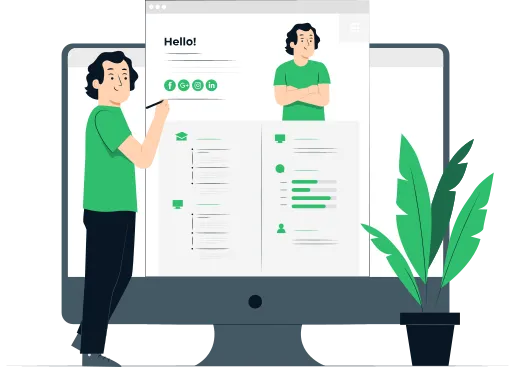
Build your Resume in 15 minutes
Create an awesome resume that meets the expectations of potential employers with our selection of professional, field-tested resume templates.

